Plant of the Month: March 2011
|
| Autumn Cyclamen |
| Cyclamen hederifolium Ait. 1789 |
| = C. neapolitanum Ten. |
PRIMULACEÆ; Primrose Family (or MYRSINACEÆ; Myrsine Family)
|
| There are 22 species in the genus Cyclamen. One is much grown in Seattle gardens and is naturalized here; it is my present subject. Names for it are: Baby Cyclamen. Ivy-leaf Cyclamen. Fall or Autumn Cyclamen. Hardy Cyclamen. Sowbread (plant) --or Swinebread (based on Medieval Latin panis porcinus --the tuberous roots are eaten by swine.) Hence the French Pain de Pourceau, German Saubrot, and Italian Pane Porcino. |
| Its native land is from S France to SW Asia. Valued for ease of cultivation, it needs zero care, being pest and disease free, cold hardy, and drought tolerant. Dark green foliage that is attractively marbled and recalls ivy (Hedera), emerges in winter and early spring, then dies down in summer's dryness. Thereafter, vivid pink or white flowers are borne August into October. Beautiful and charmingly distinctive, the blossoms are faintly rose-scented at the warmest part of day (the white-flowered variants more so). After pollination, the flowers wither and the seed pod stem coils itself like a little snake and buries itself in the ground. Ants are attracted to the seeds and spread them around. That explains why I have 8 clumps of Cyclamen in my garden --yet had planted years ago only one. Each plant comes from a flattish tuber, shaped much like a dark brown or black pancake. These tubers can grow eventually to the size of dinner plates. |
| The scientific name Cyclamen, used for centuries before being adopted officially by Linnaeus in 1753, is said to be probably derived from the Greek word for circle, in allusion to the plant's spirally twisting seed stalks --or the roundish outline of its tubers. The British pronunciation is SICK la men; most of us in the United States prefer SIGH kla men. |
| The plant is slightly toxic. It has been used sparingly in traditional herbal medicine. In his 1597 Herbal, John Gerard wrote of it: "Being beaten and made into trochisches, or little flat cakes, it is reported to be a good amorous medicine to make one in love, if it be inwardly taken." |
A love potion --if it worked-- would pose an intriguing dilemma: is it better to gain love using artifice, or to risk rejection using honesty? In the Language of Flowers, Cyclamen signifies diffidence . . .
Back |
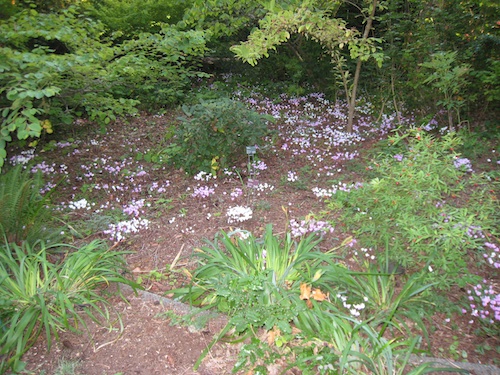
Cyclamen hederifolium in bloom at KBG, Sept. 27 2008 photo by ALJ
|
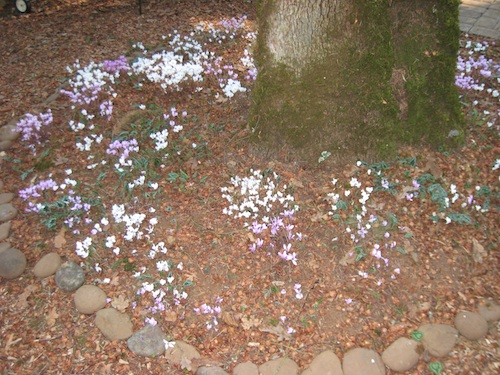
Cyclamen hederifolium in bloom in Oregon, October 5, 2009, photo by ALJ
|
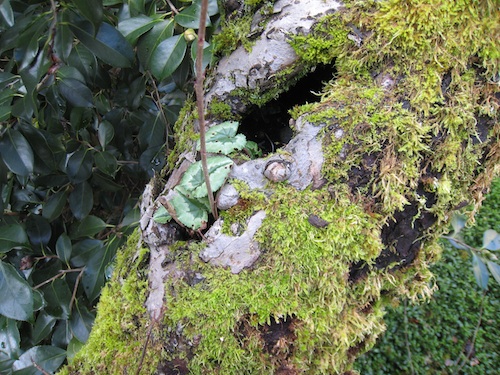
Cyclamen hederifolium as epiphyte in old apple tree limb, Feb. 22, 2011 photo by ALJ
|
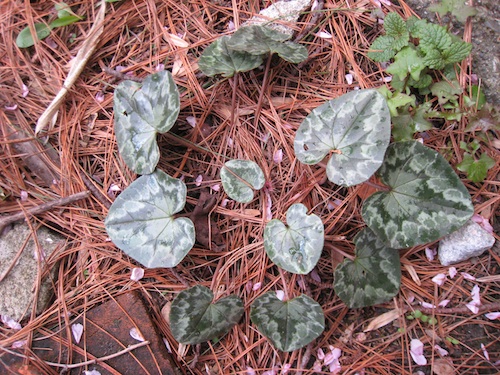
Cyclamen hederifolium wild in ALJ garden, March 25, 2011 photo by ALJ
|
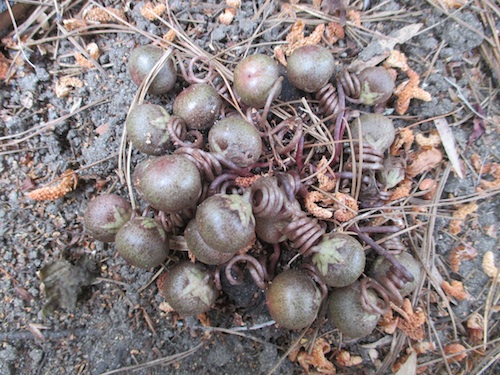
Cyclamen hederifolium seedpods, July 2nd photo by ALJ
|
|
|

